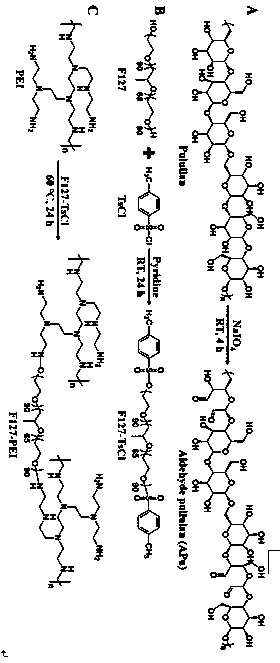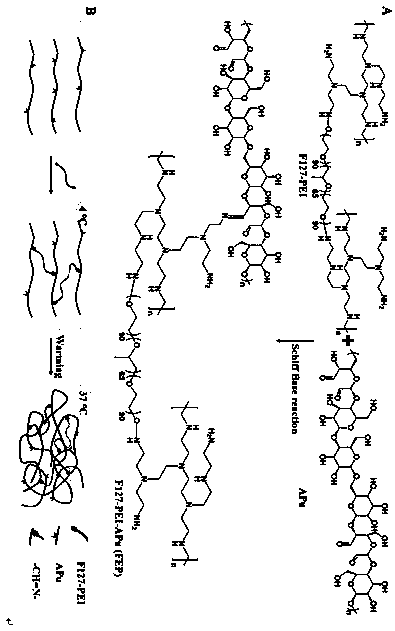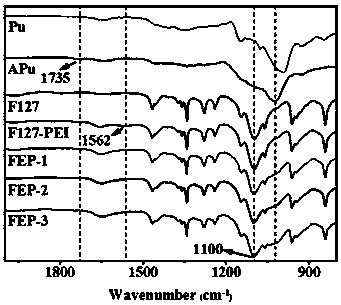Self-healing injectable hydrogel dressing for restoring diabetic wound as well as preparation method and application thereof
A technology for wound repair and water injection, applied in the field of biomedical materials and regenerative medicine, it can solve the problems of slow healing, easy wound infection, and difficult vascularization, and achieve the effects of easy access, accelerated healing, and reduced residual
- Summary
- Abstract
- Description
- Claims
- Application Information
AI Technical Summary
Problems solved by technology
Method used
Image
Examples
Embodiment 1
[0029] Embodiment 1 Preparation of hydrogel dressing
[0030](1) Preparation of alkylated pullulan (APu): Add 2 mmol of pullulan into 100 mL of deionized water, stir to dissolve completely; add 10 mmol of sodium periodate at a molar ratio of 1:5, The reaction was stirred and protected from light at room temperature for 5 hours. Then add ethylene glycol (molar ratio to sodium periodate: 2:1) to stop the reaction. After stirring for 1 hour, the reaction product was purified by 10,000 molecular weight dialysis bag for 3 days, and freeze-dried to obtain aldehydlated pullulan (APu);
[0031] (2) Preparation of F127-PEI polymer: Dissolve 0.5mmol F127 in 3.5mL dichloromethane, add 5mmol pyridine and 5mmol p-toluenesulfonyl chloride, react at room temperature for 24 hours, wash the reaction mixture with hydrochloric acid and saturated sodium bicarbonate, Precipitate with glacial ether, and the precipitated product is vacuum-dried to obtain F127-TsCl. Dissolve 0.25mmol F127-TsCl in 5...
Embodiment 2
[0034] Example 2 Preparation of Hydrogel Dressing
[0035] (1) Preparation of alkylated pullulan (APu): Add 2 mmol of pullulan into 100 mL of deionized water, stir to dissolve completely; add 10 mmol of sodium periodate at a molar ratio of 1:5, The reaction was stirred and protected from light at room temperature for 5 hours. Then add ethylene glycol (molar ratio to sodium periodate: 2:1) to stop the reaction. After stirring for 1 hour, the reaction product was purified by 10,000 molecular weight dialysis bag for 3 days, and freeze-dried to obtain aldehydlated pullulan (APu);
[0036] (2) Preparation of F127-PEI polymer: Dissolve 0.5mmol F127 in 3.5mL dichloromethane, add 5mmol pyridine and 5mmol p-toluenesulfonyl chloride, react at room temperature for 24 hours, wash the reaction mixture with hydrochloric acid and saturated sodium bicarbonate, Precipitate with glacial ether, and the precipitated product is vacuum-dried to obtain F127-TsCl. Dissolve 0.25mmol F127-TsCl in 50m...
Embodiment 3
[0039] Example 3 Preparation of Hydrogel Dressing
[0040] (1) Preparation of alkylated pullulan (APu): Add 2 mmol of pullulan into 100 mL of deionized water, stir to dissolve completely; add 10 mmol of sodium periodate at a molar ratio of 1:5, The reaction was stirred and protected from light at room temperature for 5 hours. Then add ethylene glycol (molar ratio to sodium periodate: 2:1) to stop the reaction. After stirring for 1 hour, the reaction product was purified by 10,000 molecular weight dialysis bag for 3 days, and freeze-dried to obtain aldehydlated pullulan (APu);
[0041] (2) Preparation of F127-PEI polymer: Dissolve 0.5mmol F127 in 3.5mL dichloromethane, add 5mmol pyridine and 5mmol p-toluenesulfonyl chloride, react at room temperature for 24 hours, wash the reaction mixture with hydrochloric acid and saturated sodium bicarbonate, Precipitate with glacial ether, and the precipitated product is vacuum-dried to obtain F127-TsCl. Dissolve 0.25mmol F127-TsCl in 50m...
PUM
 Login to View More
Login to View More Abstract
Description
Claims
Application Information
 Login to View More
Login to View More - R&D
- Intellectual Property
- Life Sciences
- Materials
- Tech Scout
- Unparalleled Data Quality
- Higher Quality Content
- 60% Fewer Hallucinations
Browse by: Latest US Patents, China's latest patents, Technical Efficacy Thesaurus, Application Domain, Technology Topic, Popular Technical Reports.
© 2025 PatSnap. All rights reserved.Legal|Privacy policy|Modern Slavery Act Transparency Statement|Sitemap|About US| Contact US: help@patsnap.com



